The Role of the Private Forest Sector in Ecosystem Restoration: Diverse Voices Speak about TFD’s Restoration Scoping Dialogue

By Alex Weyerhaeuser ’23 MEM, TFD Communications Associate
Forestry experts from around the world representing a diversity of perspectives, backgrounds, and interests convened in New Haven, Connecticut January 31-February 1, 2023 for The Forests Dialogue (TFD) Restoration Scoping Dialogue. Over 25 representatives from the private forest sector, NGOs, academia, and investment and intergovernmental organizations from six continents collaborated to delve into and explore the role of the private forest sector in ecosystem restoration and the value of a TFD-led process to advance ecosystem restoration around the world. “There is so much need and direction for work happening in restoration right now, so through dialogue we got some clarity about what the value of a TFD-led process could be,” TFD Associate Director Liz Felker ’19 MESc explained.
Felker shared two key decisions that shaped how this TFD dialogue would be different from other conversations happening in restoration: first was its focus on the private sector— “as understood broadly,” she clarified. “It’s not only companies, but community forests, smallholders, Indigenous communities, and all commercial interests in forests.” This unique focus on the private sector sets TFD’s Restoration Initiative apart from most other ecosystem restoration work and is especially important given that approximately 20% of global forest land is privately owned.[1] The second distinction was to look at the role of the forest sector in ecosystem restoration broadly, because the forest sector is not only engaged in forest restoration but also supports restoration of wider landscapes and ecosystems, including waterbodies and grasslands.
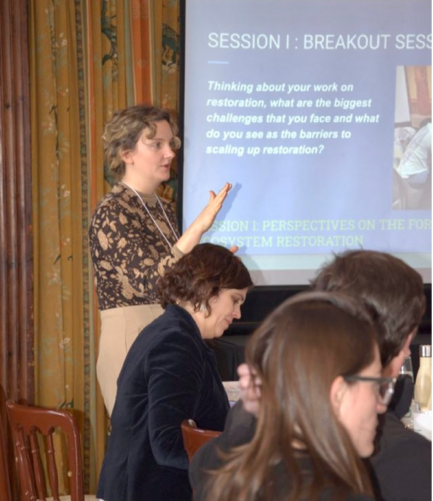
TFD’s Liz Felker introduces breakout session discussion to identify challenges and barriers to scaling up restoration efforts during day 1 of the Restoration Scoping Dialogue. Photo credit: TFD.
“It is important that we better understand how the private sector can scale up restoration efforts,” explained Lyndall Bull, dialogue co-chair and forestry officer at the Food and Agriculture Organization of the United Nations (FAO). An FAO roundtable session in Rome on “enhancing forest sector engagement in ecosystem restoration” in October 2022 became the start of TFD’s collaboration with FAO on this topic. The roundtable provided the chance for private sector representatives to explore common ground and the nuances, challenges, and opportunities in how to engage in restoration.
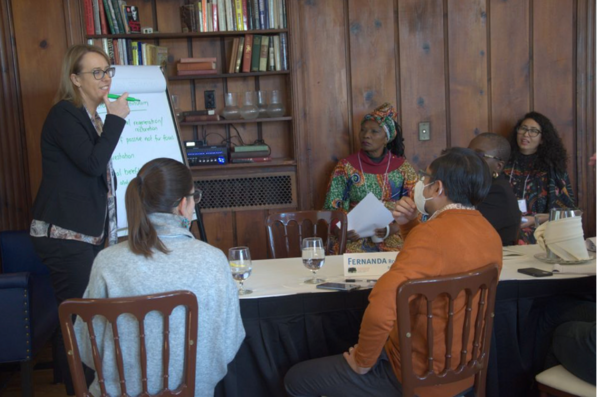
Lyndall Bull (left) facilitates breakout session on regeneration and restoration during day 1 of the dialogue. Photo credit: TFD.
The scoping dialogue advanced the conversation with objectives to:
1) Build a collective understanding of stakeholder perspectives and concerns, knowledge and research gaps, and priorities related to the forest sector’s roles in ecosystem restoration.
2) Identify areas of agreement, disagreement, and fracture lines.
3) Contribute to removing barriers and scaling up ecosystem restoration collaboration globally.
4) Scope opportunities for dialogue to drive change and foster learnings in specific locations through field dialogues and at global and regional levels.
Expanding the roundtable conversation to include stakeholders involved across the forest sector captured the complexity of ecosystem restoration. “The only way to solve complex systematic problems is to devise solutions with groups that reflect society,” explained Kerry Cesareo, dialogue co-chair and senior vice president of forests at the World Wildlife Foundation (WWF). “We need to have multiple views and perspectives because otherwise we run the risk of devising solutions that are limited in their potential to conserve forests. TFD’s model of having a global scoping dialogue as well as field-based dialogues integrates top-down and bottom-up ways to leverage experiences on the ground and inform global solutions.” The role of the co-chair is to plan and facilitate the dialogue to ensure this diversity of perspectives is included, summarize dialogue discussions to capture the big picture, and address participants’ questions and doubts—a challenging role Bull, Cesareo, and Sarah Price ’06 MFS, the third co-chair and sustainability manager at Sappi, expertly executed.
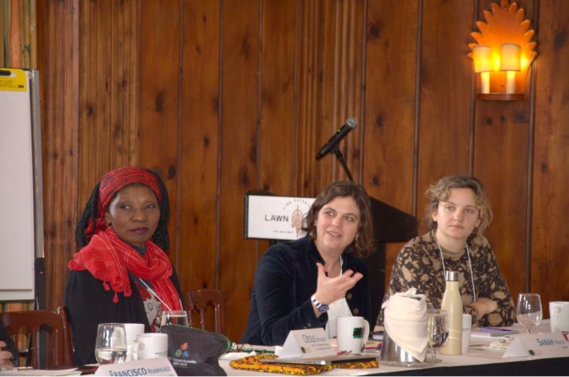
Cécile Ndjebet (REFACOF), Sarah Price (Sappi), and Liz Felker engage in plenary discussions during the dialogue. Photo credit: TFD.
The various contexts and motivations converged in dialogue, continuously evolving as synergies, inspiration, and tensions emerged. From Bull’s intergovernmental perspective, this dialogue was crucial for opening economic opportunities and drawing on the private forest sector’s scientific expertise and insights to contribute to the sustainable bioeconomy. FAO’s statement on ecosystem restoration, which was released during the dialogue, stressed the importance of scaling up successful business models that integrate restoration, embody the goals of the United Nations Decade on Ecosystem Restoration, and “build the capacities of value-chain partners for harnessing emergent opportunities.”
This hopeful perspective was somewhat countered by Claudio Guevara, who joined the dialogue representing the International Forestry Students’ Association (IFSA), one of the largest international networks of students in forestry and a key partner of TFD to enable youth engagement in multi-stakeholder forest dialogue. Guevara came to the dialogue representing this younger generation of students hesitant about joining the private sector, as in his experience he had seen little commitment to change from the industry. “I felt like I had to be the voice that raised the need for deeper changes and faster, stronger commitments,” he said. He expressed concerns about the urgency of restoration work and the need to hold private companies accountable for their role in ecosystem fragmentation, forest clearcutting, monoculture agriculture, and other management problems that contributed to the current dire situation. “I think we are putting them on too high a pedestal,” he confessed. “The main restoration efforts are being carried out by nonprofits and small communities. I haven’t seen any big forest company leading a big restoration project successfully.” He recognized this dialogue as the moment to “bring all possibilities to the table” and felt it was important to push back and say, “What about changing the way things have always been done instead of just patching it up?”
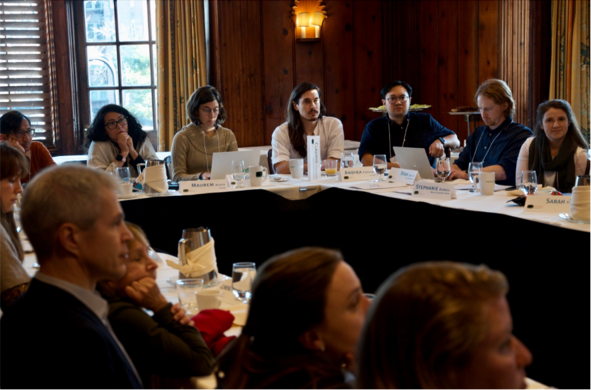
Claudio Guevara (center) places his name tent vertically, an indication in the dialogue process that a participant would like to speak. Photo credit: TFD.
Cesareo, representing WWF, an international environmental non-profit organization, also acknowledged the gap in restoration from the private forest sector: “We see a lot of potential and relevance for the private forest sector to engage, but where they might not be engaging as much as they could be when we consider the sheer scale and urgency around scaling up forest landscape restoration.” This gap highlights the importance of bringing the private sector in, encouraging the work they are doing and catalyzing further collaborations. “It’s a strategic and relevant focus,” Cesareo explained, “and while there are aspects of it that might have felt uncomfortable or obviously narrowed the conversation, I think it allowed for a more targeted conversation.” This focus was invaluable to the dialogue and essential to providing an opportunity for the private sector to hear expectations around their engagement and for them to share their motivations as well as limitations to engage.
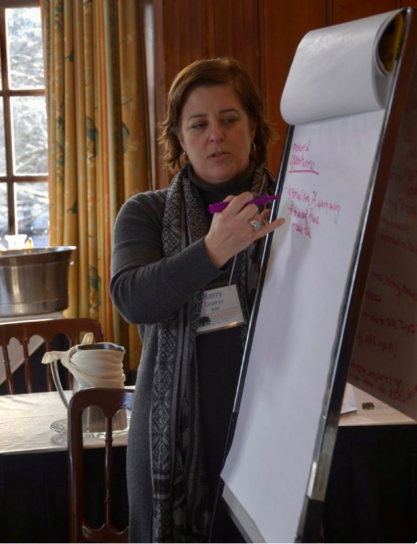
As scoping dialogue co-chair, WWF’s Kerry Cesareo facilitates a breakout discussion on restoration opportunities. Photo credit: TFD.
Maurem Alves, sustainability consultant at Klabin and member of the Brazilian Forest Dialogue, came to the Restoration Scoping Dialogue excited not only to share her own experience working in restoration in the private sector and her learnings from successes and failures over the years, but to listen and to improve her own work—a view she found in common with the other private sector representatives in attendance. She left with the realization that the private sector must improve the way they spread information about the restoration work they do and the challenges they face, a communication discrepancy that was not clear to her before the dialogue. She remains committed to exploring how the industry can be a force to propel scaling up solutions in restoration to the global level. “I think these small tensions are positive because they are the ingredients that make people realize that their own reality is not the only one,” Alves reflected.
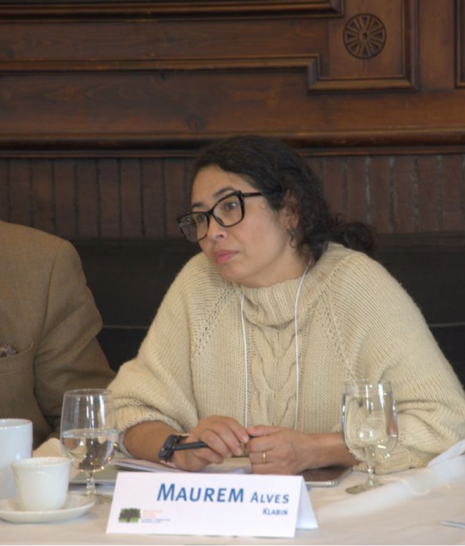
Maurem Alves, a private sector representative, prioritizes listening and communicating during the dialogue. Photo credit: TFD.
“I believe that the forest sector has a lot to offer from a skills and knowledge perspective and against the backdrop of societal and environmental challenges and increasing demand for bio-based products,” Bull reflected. These contrasting and complementary perspectives illuminate the nuance and complexity of this topic and raise questions around what constitutes restoration, what or who we’re restoring ecosystems for, the tradeoffs that must sometimes be made, and the inability to make generalizations because it’s so context-specific.
The dialogue gave rise to three frames of reference for how to approach the issues and complexities around restoration. The first was around acknowledging the spectrum of restoration activities—from intensively-managed plantations to managing for natural regeneration. Next, participants explored the private forest sector’s different spheres of engagement—from the direct land base they manage, to the landscapes in which they operate, to the global sphere. The third frame involved incentives and disincentives to help guide companies’ behavior in a positive direction, acknowledging their differing motivations and intentions. Through each of these frames, fracture lines—or underlying tensions beneath areas of disagreement—emerged. “The global scoping dialogue is not about solving fracture lines, it’s not about coming to completion or defining the way forward, but it did allow for grappling with and drawing out more of the perspectives and digging into them using those three frames,” Cesareo explained. “This was an artful way to get the most from a group of people together for two days in a wide-ranging and complicated conversation.”
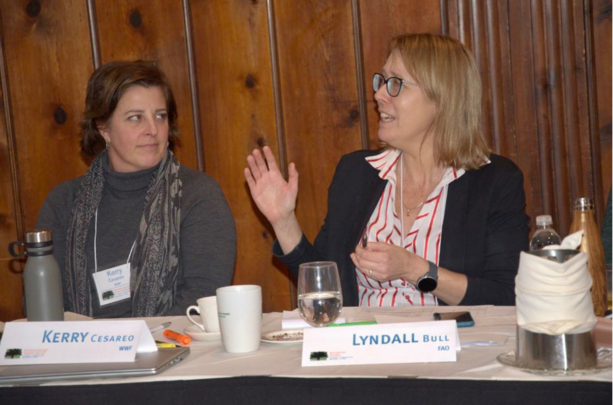
Scoping dialogue co-chairs Kerry Cesareo (left), Lyndall Bull (right), and Sarah Price (not pictured) plan and facilitate the dialogue to ensure a diversity of perspectives is included, summarize dialogue discussions to capture the big picture, and address participants’ questions and doubts. Photo credit: TFD.
This framing and TFD’s approach allowed for a productive conversation, even in moments of disagreement. Guevara, who is finishing his PhD this spring, has changed the way he thinks about his future after experiencing TFD’s dialogue process, realizing how much work there is to do in restoration and the need for building partnerships, connecting dots, and dialoguing “because there are so many pieces in this work that don’t talk to each other or, if they do, they don’t leave their positions.” But he did recommend opening the dialogue to more creativity in the future—not always being so structured and conservative in this scoping process, but imagining a more idealistic future as well as scenarios in which things go wrong.
It is crucial for industry leaders to listen to the pulse of this young generation of students and future foresters. The dialogue coincided with a confluence of TFD and The Forest School (TFS) events at Yale: TFD Week, TFD’s Steering Committee meeting, and the International Society of Tropical Foresters (ISTF) annual conference. This concurrence of events fostered a week of abundant knowledge sharing for students and dialogue participants and inaugurated the spring semester at Yale, inspiring students engaged in forestry and restoration work.
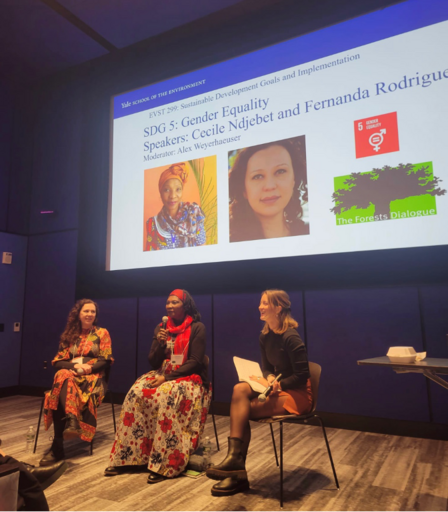
TFD Steering Committee members Fernanda Rodrigues (left) and Cécile Ndjebet (center) speak on a panel facilitated by TFD Associate Alex Weyerhaeuser ’23 MEM (right) about gender in forestry in a Yale College class about Sustainable Development Goals during TFD Week. Photo credit: Phoebe Herring ‘23 MEM, ‘Sustainable Development Goals’ Teaching Fellow.
The concurrence of these events created a dialogue of its own as participants cross-pollinated ideas. Cesareo, Bull, Felker, and other participants all echoed the value of co-locating these activities and the energy and intellectual curiosity students brought to the discussions. “It brought home the importance of what we do and we were immediately able to share some of our findings with the broader group,” Bull explained. “It was really nice to be in a room with people that share some common passions when it comes to forests, even if they’re coming from different places, experiences, and backgrounds,” Cesareo added. “It’s good to have spaces like that when you’re trying to advance largescale ambitions about sustainability of forests globally. That’s what allows people to continuously recommit to TFD and makes TFD different from other more generic multi-stakeholder forums that are less personal or have less heart.”
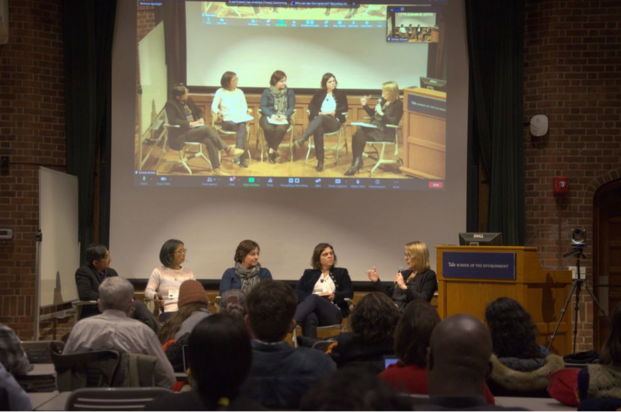
Left to right: Gamma Galdura (RECOFTC), Ivone Namikawa (Klabin), Kerry Cesareo, and Sarah Price speak on a panel facilitated by Lyndall Bull (right) about Building Partnerships for Forest Restoration during TFD Week. Photo credit: TFD.
As the dialogue came to a close, participants felt it was time to move the discussion topics from the scoping stage to field dialogue. Different priorities emerged in this discussion and TFD and the Restoration Initiative Advisory Group are exploring multiple locations for field dialogues. Participants are excited to continue the next stage of this work, dive deeper into dialogue to better understand each other’s perspectives, and collaborate with one another. “We need to concentrate our efforts on finding common ground and not waste time on divergences and the things we cannot agree on,” Alves concluded. “This is a principle in the dialogue process but something we need to remind ourselves constantly.”
[1] Whiteman, A., Wickramasinghe, A., & Piña, L. (2015). Global trends in forest ownership, public income and expenditure on Forestry and Forestry Employment. Forest Ecology and Management, 352, 99–108. https://doi.org/10.1016/j.foreco.2015.04.011
